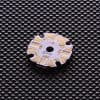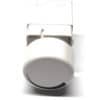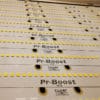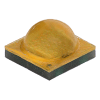Consumer Lighting
Ultimate Guide to Installing LED Strip Lights for Shelving
Ultimate Guide to Installing LED Strip Lights for Shelving
Enhancing your shelving with our Ultimate Guide to Installing LED Strip Lights for Shelving. LED strip lights is not only a practical choice for illumination but also adds a contemporary aesthetic to any space. LED strip lights, with their unmatched flexibility and ease of installation, are the go-to solution for modern lighting challenges. Here, we explore the technical specifications, benefits, and detailed installation processes for LED strip lights, ensuring you make the most of this innovative lighting solution.
Why LED Strip Lights are Essential for Shelf Lighting
LED strip lights have transformed the lighting landscape with their remarkable efficiency and longevity. Perfect for both residential and commercial applications, these lights offer unparalleled flexibility, making them ideal for custom shelf lighting solutions. Here’s why they’re indispensable:
- High Efficiency: LED strips are known for their energy efficiency, consuming less power than traditional lighting options like incandescent and fluorescent lights, which translates to significant energy savings.
- Flexibility and Customization: Available in various lengths, LED strips can be cut to specific sizes and are flexible enough to fit any shelf design. Their ability to fold and bend makes them perfect for lighting corners and intricate spaces.
- Enhanced Aesthetics: LED strips provide excellent accent lighting, improving the visual appeal of any area. They are particularly effective in settings where mood lighting is essential, such as retail displays or under kitchen cabinets.
- Low Voltage : Led Strips are available in safe low DC voltage, making them a simpler, safer choice for the novice or seasoned DIYer. Its an important distinction but voltages in order of low to high, do offer the benefits of longer strip runs per led driver before needing to inject or add power supply via led strip drivers
Technical Specifications and Installation Options
- Adhesive Backing Installation: Most LED strips come with a self-adhesive backing that allows for easy placement and mounting on various surfaces, eliminating the need for drilling or complex hardware. This feature also makes them useful for placement in extrusions which may provide you with a more robust and aesthetic finish, especially if you plan to recess/route your strip.
- Secure Installation with Clips or Channels: For environments where a more durable installation is necessary, securing LED strips with mounting clips or embedding them into aluminum channels can ensure stability and a seamless aesthetic.
- Energy Source Adaptability: LED strips can be powered through direct wiring to household electricity, batteries, or plug-in adapters, offering versatility based on the installation site and available power sources.
Detailed Installation Guide
- Surface Preparation: Before installation, ensure the shelf surface is clean and free from dust or grease to guarantee the adhesive bonds well.
- Measuring and Cutting: Measure the length of the shelf to determine how much strip is needed. Most LED strips can be cut at marked intervals to fit perfectly. Always check the cut length of a strip before purchase to ensure increments are size compatible with your design
- Attaching the Strip: Peel off the backing and stick the strip directly onto the shelf, pressing firmly to secure it. For corners, gently fold or bend the strip without twisting the LEDs. Consider leaving a gap when fitting to corners to avoid corner flare
- Power Connection: Connect the strip to your chosen power source. If using a plug, ensure the connection is near an outlet or use an extension.
- Final Testing: Once installed, test the strip by turning on the power to ensure all sections are lit and functioning correctly.
Considerations for Optimal Lighting
- Color Temperature: Choose a color temperature that complements the room’s purpose—warmer tones for cozy spaces like bedrooms and cooler tones for workspaces. Check our range and use Colour Temperature filters to speed up your search
- IP Rating: For shelves in kitchens, bathrooms, or outdoors, use strips with a suitable IP rating to withstand moisture and dust.
- CRI (Color Rendering Index): For shelves displaying color-critical items, such as in retail or galleries, opt for LED strips with a high CRI to enhance the true colors of the objects. Check our range and use CRI filters to speed up your search.
Match Led Strip to your Shelf Environment
Color Of The Shelves: You have to choose a color strip that matches your shelves. Wooden shelves look best with warm-colored LED strips. You can choose yellow or orange tones fixtures for these shelves. However, dim-to-warm LED strip lights work best in this case. You can use them on the shelves of your bedroom, bathroom, living area, or any other space where you want to create a cozy ambiance. These strips allow you to adjust the CCT to get your perfect warm color. Besides, if you have colorful shelves, go with the rule- warm for warm and cool for cool. Use cool white LED strips if your shelves are painted in cool colors like blue, green, etc. Use warm white LED strips if painted in warm colors like yellow, red, orange, brown, or similar colors. However, tunable white LED strips work best for all types of shelves as they can be customized from warm to cool hues.
- Material Choices: Consider aspects of your material choices, for example reflectivity. Glossed paint or reflective material types like polished aluminium or glass will reflect more light. This may result in facetting or aberration’s in the overall light effect. If its desired it may require more careful consideration of the design. Perhaps more importantly it could introduce glare, which could bring the whole design undone if your light is difficult to view. If this is the case you should always consider options of placing strip in an extrusion with a diffusor with an opacity level that proportionally mitigates light ‘bounce’ with reflective surfaces
Powering your Leds: Options for led power are numerous and dependent on existing power availability relative to your design
- Battery power: many strips can operate at 5v and can be powered and charged with options like USB. The issue’s to consider are if you need to use battery power, you will likely need a location for battery, charger, on/of switch and you will need to integrate that into your shelving in a manner that is least visible. One of the down sides of 5v powered strips will be the limitations of strip length relative to a 5V power source. You can however create some cool visual effects with many types of 5v Digital Pixel type strip so nice option for an outdoor garden Bar without mains power.
- Mains power: This will be your most flexible option, albeit needing a power source or socket where you plan the lighting install
- Led drivers: All leds need some kind of driver to power and control the leds, so beyond the issue of power to the light source, you will need to accomodate a led driver at the power source point. Typical choices would be
- ceiling mounted and accessing existing wiring/switches
- wall cavity, perhaps using existing switch cavities
- external to the house structure but hidden in some part of the shelving architecture
- controllers could be utilised in cavities ie small dimmers wired or wireless ( Bluetooth, zigbee, Wave etc)
Advanced Tips for Professional Results
- Using Dimmers: Incorporate dimmers to control the brightness of the LED strips, allowing for adjustable lighting based on time of day or desired ambiance.
- Smart Controls: Integrate smart lighting controls to manage your LED strips via a smartphone app or home automation system, providing convenience and energy efficiency.
- Routine Maintenance: Regularly clean the strip surface and check connections to ensure long-term performance and safety.
Where to Mount your Strips
Placement Of LED Strip On The Shelves
Front Of The Shelves: Installing the LED strips in the front(under) of the shelves illuminates direct light and is more functional. This method will aid in more light for tasks and avoid backsplash issues. You can install the strips around the front of your shelf for tasked based applications. This is often very useful for cupboards or pantries that have no existing light sources. This placement will eliminate shadowing issues. The example shown is recessed/routed into shelves and while the light is perpendicular, this could be further enhanced by using shelve routing of a size that could allow for angled extrusions to shape the beam further across the lower shelf. To do this would require more consideration re the distance of the routed hole to front of the shelf and overall width and depth of the lower shelf. A good example of front mounting would be book shelves that allow spined titles to be well lit for selection.
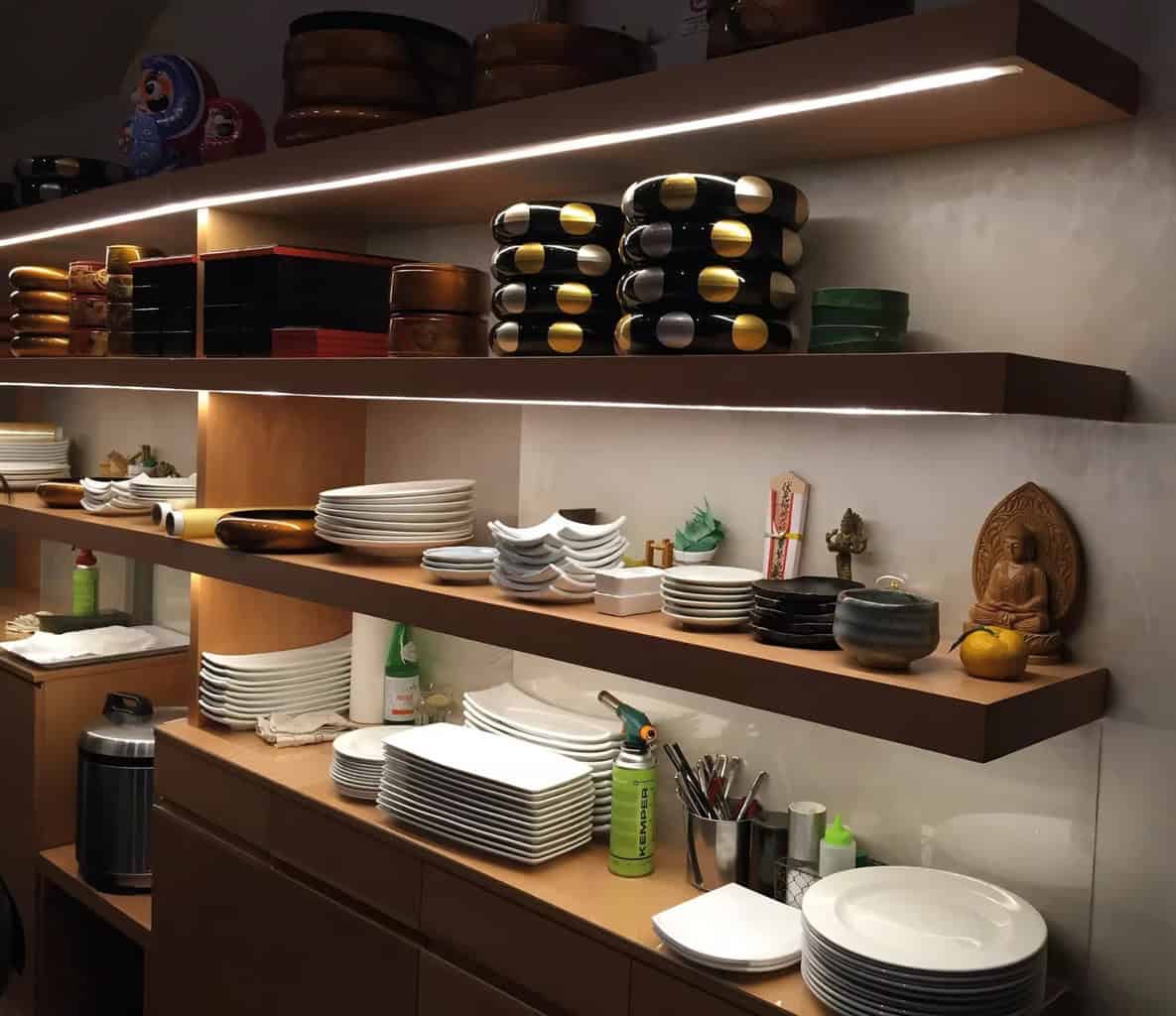
Middle Of The Shelves : You can install strip in the middle of the shelf to light up the entire space under the shelves. This process is a balanced approach, it mixes task and aesthetic. It will share the light equally front and back of the lower shelf. You need to consider the strip’s size and density for equal brightness balance. Install high-density LED strip lights on the middle of the shelf to ensure the brightness of all sections evenly. Again, you can use an LED diffuser to reduce harsh glaring and reflection for less demanding zones like nic nak shelves.
Rear Of The Shelves:
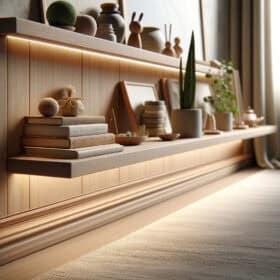
This can be considered the most ambient light approach.Examples would be LED strips on the back of your kitchen counter as a secondary option for indirect glow.
When your kitchen counter has enough natural or ambient elementary light, mounting to the back of the shelf is a good option, even when not required it can provide subtle light to the heart of the house and you can experiment with a warm tone light to create a cozy and warm vibe. You can apply yellow, orange, amber, and pink colors to your interiors and make a warm environment.
Top 7 Ideas To Light Shelves Using LED Strip
LED strip light is outstanding for architectural cabinet lighting. You can follow different installation processes for the indoor and outdoor shelves. Commercial lighting will be different, bulkier, and more functional. So, you have to plan your DIY shelf projects wisely. Below, I have added 7 excellent ideas for your cabinet projects
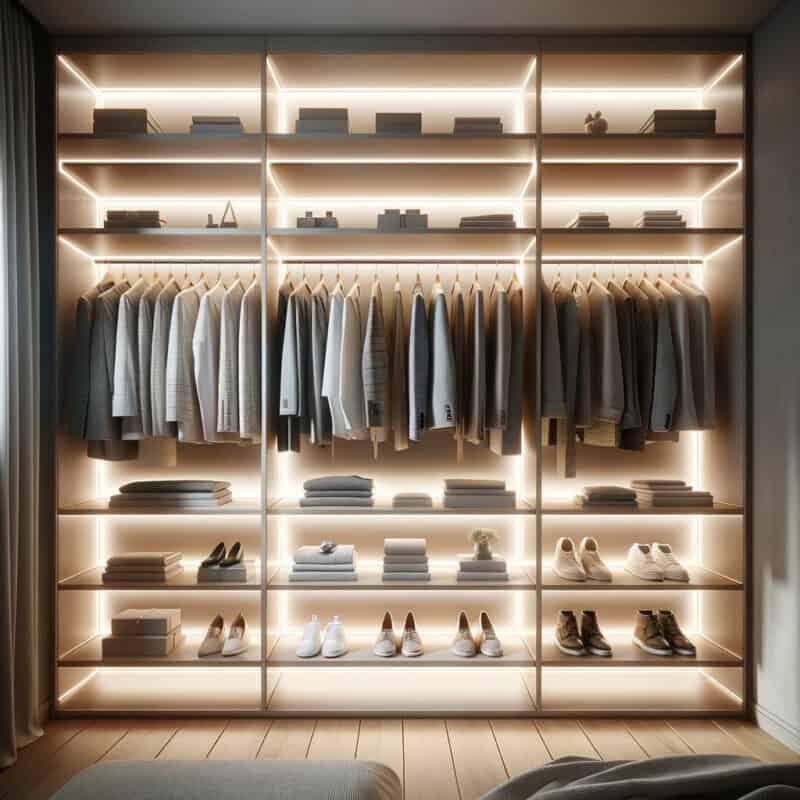
1.Closet Shelf Lighting
Closet shelf lighting is popular for DIY cabinet projects. You must select the correct color and installation process according to the closest color and location. For instance, you can install warm-tone lights along the closest front, as accent lighting provides accurate visibility and prevents your clothes from harsh rays. Additionally, you can install battery-powered LED strips inside the closet or wardrobe back portion. Thus, you can enjoy wireless-free secure functions inside the closet and drawers. Also, it aids in lighting up the hard-to-tough corners and specific areas like shoe racks in every drawer.
2.Bathroom Shelf Lighting
The LED strip light provides your bathroom with practical natural illumination. There are a lot of shelves to install the LED strip lights in the bathroom. You should go with higher IP ratings and a warm tone for bathroom cabinets. A Dim-To-Warm single-color install around the cabinet frame makes your bathroom warm and comfortable. Also, you can experimentally install the LED strip 2-3 inches backward from the front edge of the shelves around the mirror. This type of installation creates accurate visibility and brightness for applying makeup and shaving
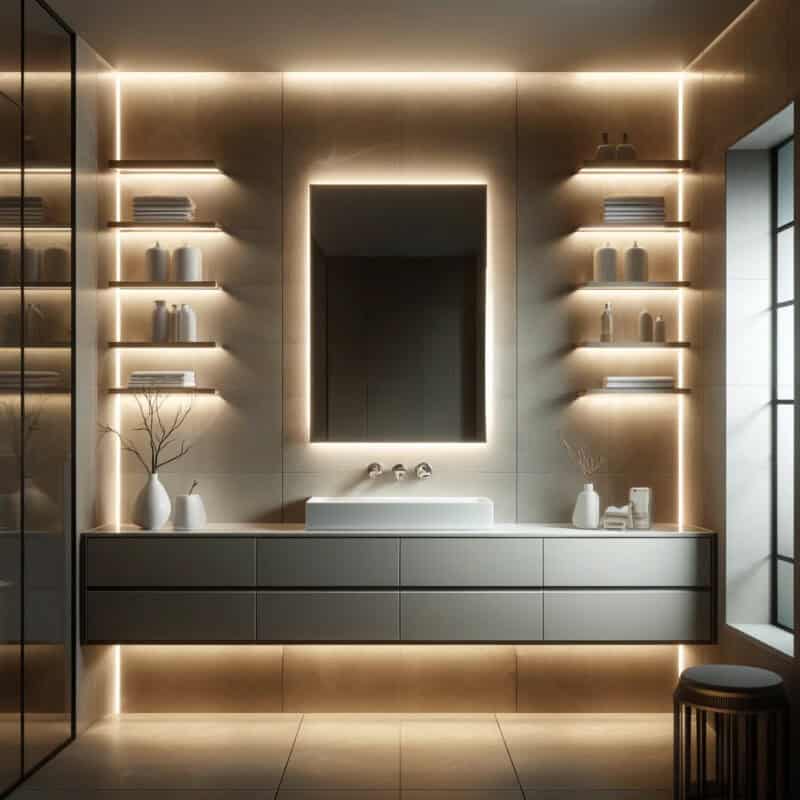
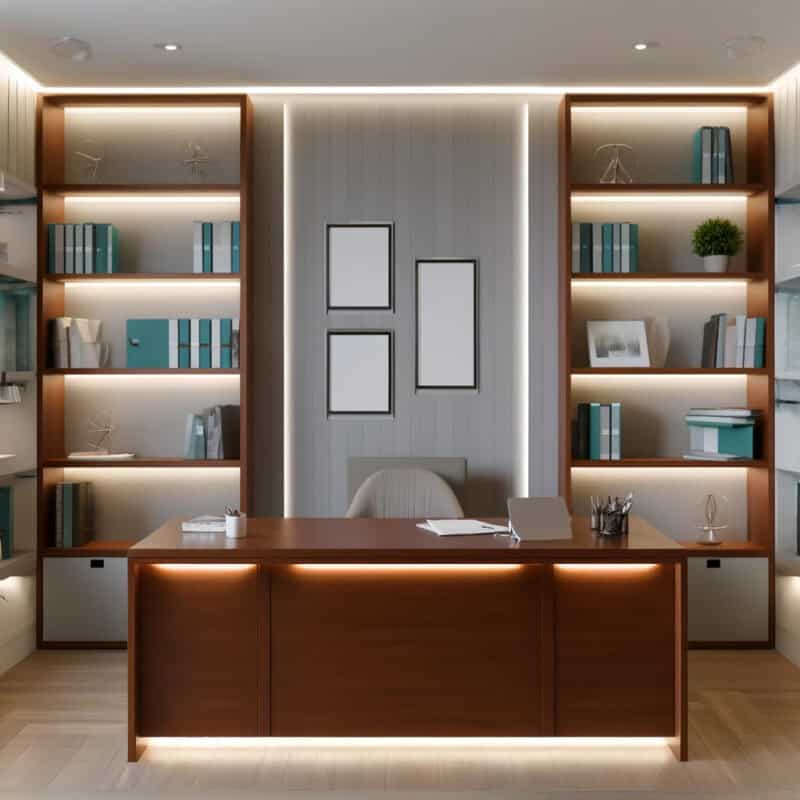
3.Office Shelf Lighting
Home Office shelf lighting is an integral part of your interior. A well-furnished office is a symbol of productivity, while creating a relaxing state. Proper lighting makes the office more attractive and gives a positive impression. You can lighten up your office in different colors and installation methods. For accent task lighting, you can install cool tone 3500K-4000K strip lights around every desk’s front shelf. Thus, you can increase the brightness for accurate visibility to make for more active and energised space.
4.Lighting Up The Shelves Of The Bar
Different bar designs are included with the interior shelves to create attractive looks. You need tricky applications when you have bars in front of the shelves. Otherwise, the light illumination will be shadowy. If a bar is around the shelf’s frame, installing the fixture 2-3 inches underneath the shelf will aid accurate illumination. Again, install LED strips of rope light inside the rack instead of LED strips of tape light to reduce the reflection issues and spread it around evenly. For this case, colorful single-color LED strips or RGB LED strips work best.
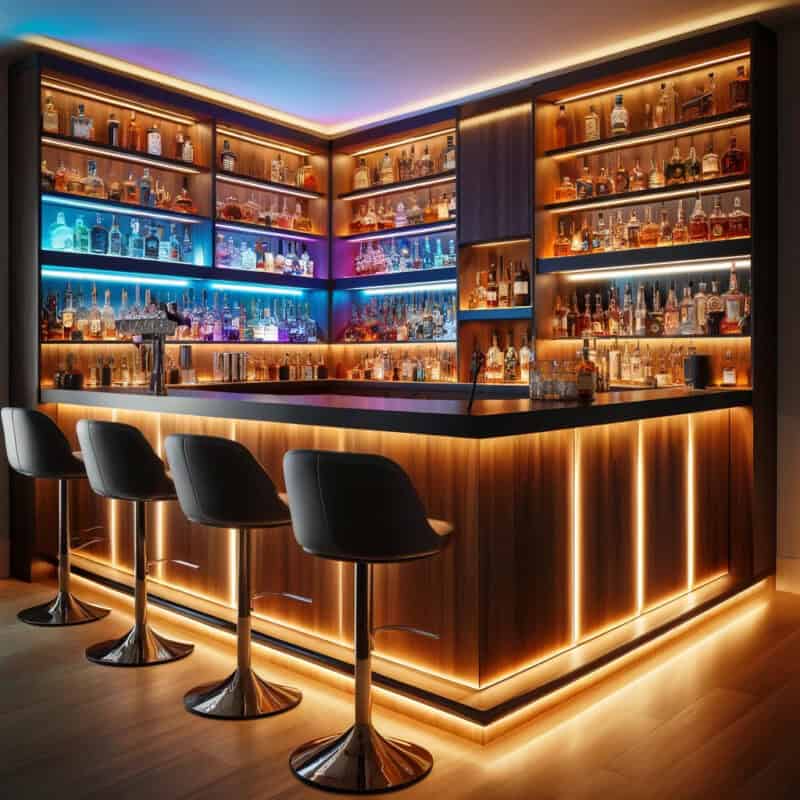
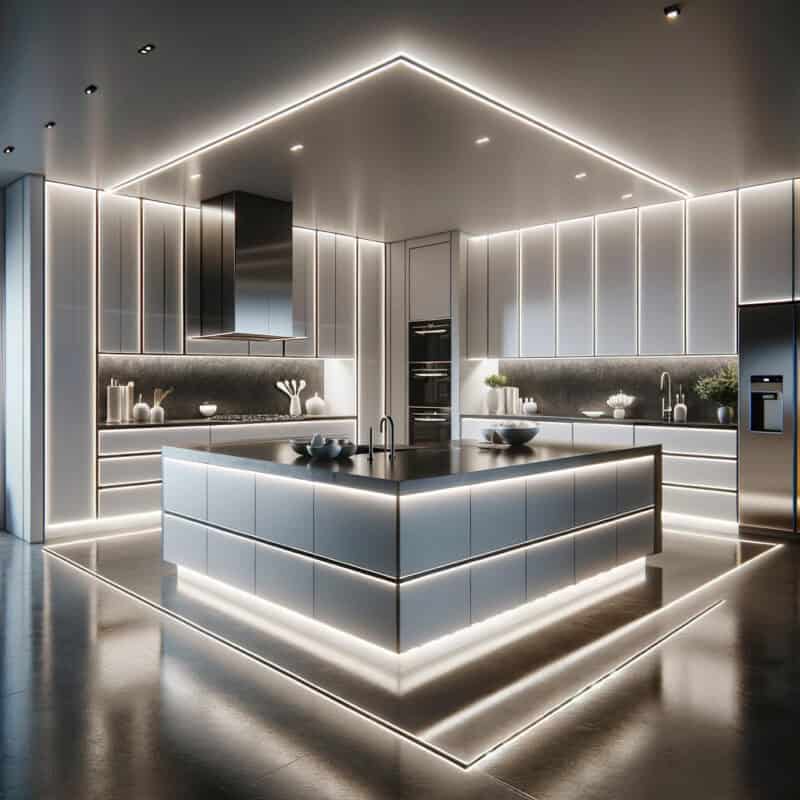
5.Kitchen Shelf Lighting
Kitchen shelf lighting will differ from bedroom or living room shelf lighting. The kitchen is the most light-demanding zone for indoor and outdoor kitchen lighting. A professional interior designer helps you with precise lighting in a commercial kitchen. If your home has a small kitchen with dark walls and cabinet colors. Also, it is less accessible to natural light. Make it spacious and comfortable using a cool tone 3500K-4000K tunable white, amber, or light pink with a high-CRI LED strip light. You won’t need to install extra light for more brightness. But there is a large kitchen with modern interiors; install LED strips along the front lip of the shelves as secondary decorative lighting. Also, a warm 3000K-3500K accent light for the countertop area makes cutting more accessible and secure. A 3500K-4100K yellow tone creates the perfect vibe for the culinary prep zone.
6.Bookshelf Lighting
Perfect bookshelf lighting is essential for reading and highlighting books. Generally, the books are arranged on the shelves in a line. Install LED strip liner lights underneath the shelves for library ambient lights that aid in finding books and reading directly. A cool white 4100K and 90+ CRI fixture is perfect for the home’s bookshelf that assists in organizing the shelves. Again, a tunable white 4100K-4500K and 95+ CRI strip light is the best for the library shelf.
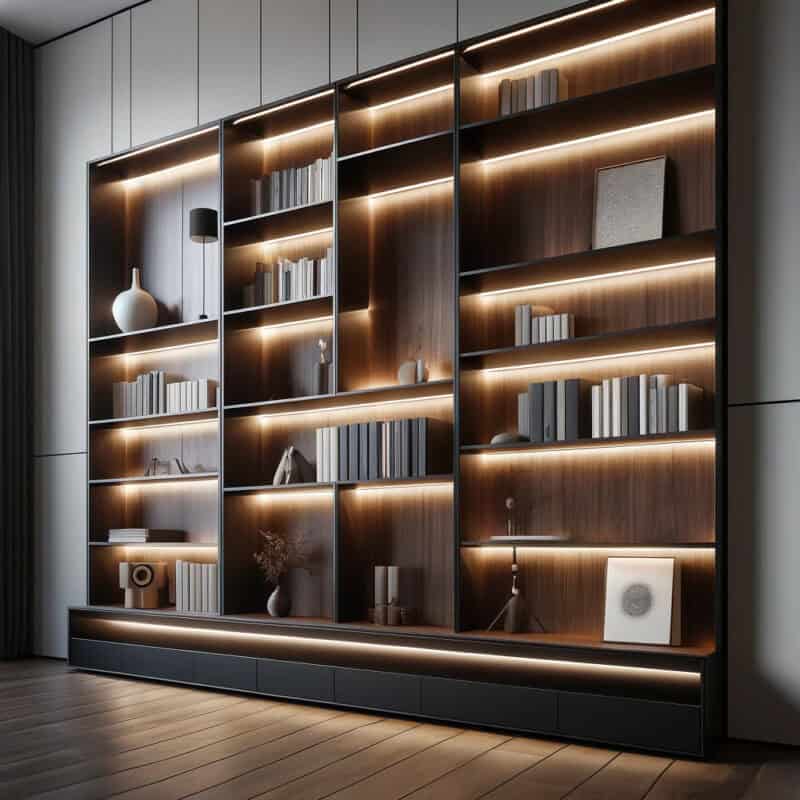
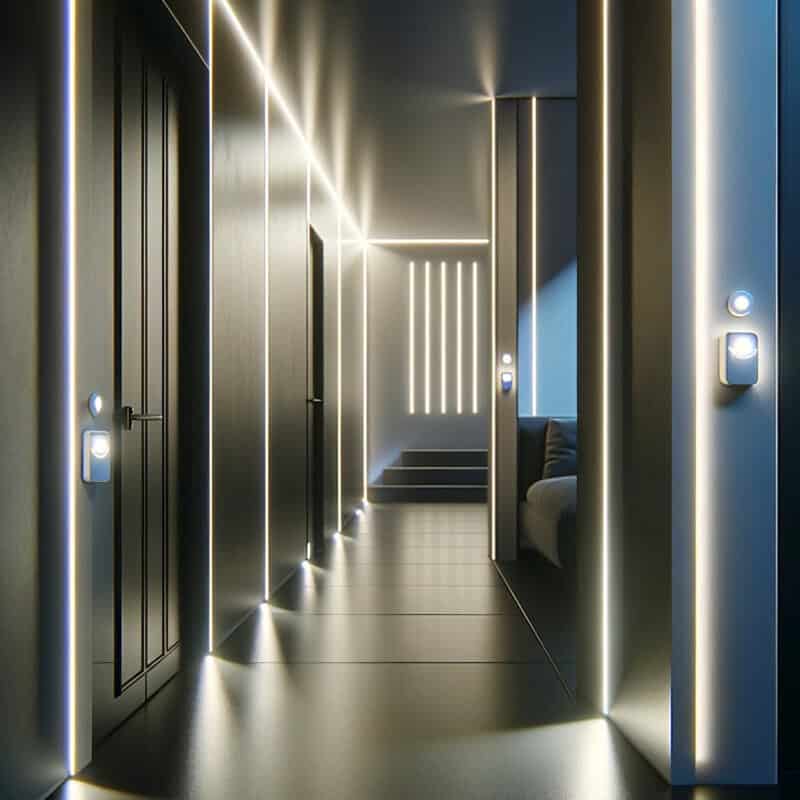
7. Motion Sensor Lighting
Motion sensor lighting brings a revolution in the modern lighting industry. A sensor is connected to the lights that detects any movement. If anyone comes in front of the light, the light turns on instantly. You can install this lighting in your bedroom closet doors, under the kitchen cabinet, and in the bathroom cabinet. When you open the closet, the light will turn on and brighten inside the closet without touching the on/off switch. You can do your night activities in silence without waking your family members. Also, connecting the motion sensor to the light increases your home’s security.
Conclusion
Installing LED strip lights on shelves is a smart, cost-effective way to enhance functionality and aesthetics in any setting. By following these detailed instructions and considering your specific needs, you can achieve professional-quality results with LED strip lighting, making any space more inviting and visually appealing.








